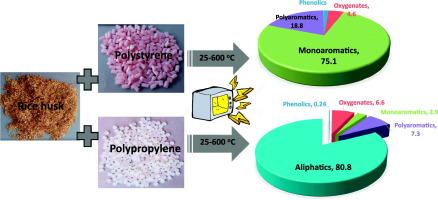当前位置:
X-MOL 学术
›
Fuel Process. Technol.
›
论文详情
Our official English website, www.x-mol.net, welcomes your
feedback! (Note: you will need to create a separate account there.)
Microwave assisted co-pyrolysis of biomasses with polypropylene and polystyrene for high quality bio-oil production
Fuel Processing Technology ( IF 7.2 ) Pub Date : 2018-06-01 , DOI: 10.1016/j.fuproc.2018.02.019 Dadi V. Suriapparao , Bhanupriya Boruah , Dharavath Raja , R. Vinu
Fuel Processing Technology ( IF 7.2 ) Pub Date : 2018-06-01 , DOI: 10.1016/j.fuproc.2018.02.019 Dadi V. Suriapparao , Bhanupriya Boruah , Dharavath Raja , R. Vinu

|
Abstract In this study, co-pyrolysis of five lignocellulosic biomass residues, viz. groundnut shell (G), bagasse (B), rice husk (RH), Prosopis juliflora (PJF) and mixed wood sawdust (MWSD), with two synthetic plastics, polypropylene (PP) and polystyrene (PS), was conducted to improve the quality of bio-oil. Equal composition of biomass and plastic was pyrolyzed at 450 W microwave power using graphite susceptor, and the yields of bio-oil, char and gas fractions were determined. The bio-oil yields from PS-biomass blends varied in the range of 51–60 wt%, with maximum yield obtained from PS-MWSD, while that from PP-biomass blends were 25–41 wt% with maximum yield obtained from PP-RH. The higher heating value of co-pyrolysis bio-oil was high (38–42 MJ kg−1) as compared to bio-oil obtained from only biomass pyrolysis (20–30 MJ kg−1). Energy yield of co-pyrolysis bio-oil was significantly higher with PS mixtures (73–81%) than PP mixtures (32–62%). Importantly, the bio-oil, char and gas yields, and organic composition of bio-oil were non-additive with respect to that obtained from pyrolysis of the individual feedstocks. The presence of PS boosted the production of aromatic hydrocarbons (48–54 wt%), while PP promoted aliphatic hydrocarbons (19–33 wt%) in co-pyrolysis bio-oil. Specifically, high selectivity towards alkanes in bio-oil was obtained from PP-RH mixture. Co-pyrolysis bio-oil contained less moisture with lower acidity compared to pyrolysis bio-oil. RH-PS and RH-PP mixtures were shown to be the better biomass-plastic combinations from the viewpoint of recovering high energy in bio-oil. The microwave co-pyrolysis process efficiency was also high (63–68%) and promising.
中文翻译:

微波辅助生物质与聚丙烯和聚苯乙烯的共热解用于高质量生物油生产
摘要 在这项研究中,五种木质纤维素生物质残留物的共热解,即。花生壳 (G)、甘蔗渣 (B)、稻壳 (RH)、胡杨 (PJF) 和混合木锯末 (MWSD),以及两种合成塑料,聚丙烯 (PP) 和聚苯乙烯 (PS),进行了改进生物油的质量。使用石墨感受器在 450 W 微波功率下热解相同成分的生物质和塑料,并确定生物油、炭和气体馏分的产率。PS-生物质混合物的生物油产量在 51-60 wt% 的范围内变化,PS-MWSD 的产量最大,而 PP-生物质混合物的产量为 25-41 wt%,PP-的产量最大。 RH。与仅从生物质热解中获得的生物油(20-30 MJ kg-1)相比,共热解生物油的热值较高(38-42 MJ kg-1)。PS 混合物的共热解生物油的能量产率 (73–81%) 显着高于 PP 混合物 (32–62%)。重要的是,生物油、焦炭和气体的产量以及生物油的有机组成与从单个原料的热解中获得的成分相比是非添加剂的。PS 的存在促进了芳烃的产生(48-54 wt%),而 PP 促进了共热解生物油中脂肪烃的产生(19-33 wt%)。具体而言,从 PP-RH 混合物中获得了对生物油中烷烃的高选择性。与热解生物油相比,共热解生物油含有较少的水分和较低的酸度。从回收生物油中的高能量的角度来看,RH-PS 和 RH-PP 混合物被证明是更好的生物质塑料组合。微波共热解工艺效率也很高(63-68%)并且很有前景。
更新日期:2018-06-01
中文翻译:

微波辅助生物质与聚丙烯和聚苯乙烯的共热解用于高质量生物油生产
摘要 在这项研究中,五种木质纤维素生物质残留物的共热解,即。花生壳 (G)、甘蔗渣 (B)、稻壳 (RH)、胡杨 (PJF) 和混合木锯末 (MWSD),以及两种合成塑料,聚丙烯 (PP) 和聚苯乙烯 (PS),进行了改进生物油的质量。使用石墨感受器在 450 W 微波功率下热解相同成分的生物质和塑料,并确定生物油、炭和气体馏分的产率。PS-生物质混合物的生物油产量在 51-60 wt% 的范围内变化,PS-MWSD 的产量最大,而 PP-生物质混合物的产量为 25-41 wt%,PP-的产量最大。 RH。与仅从生物质热解中获得的生物油(20-30 MJ kg-1)相比,共热解生物油的热值较高(38-42 MJ kg-1)。PS 混合物的共热解生物油的能量产率 (73–81%) 显着高于 PP 混合物 (32–62%)。重要的是,生物油、焦炭和气体的产量以及生物油的有机组成与从单个原料的热解中获得的成分相比是非添加剂的。PS 的存在促进了芳烃的产生(48-54 wt%),而 PP 促进了共热解生物油中脂肪烃的产生(19-33 wt%)。具体而言,从 PP-RH 混合物中获得了对生物油中烷烃的高选择性。与热解生物油相比,共热解生物油含有较少的水分和较低的酸度。从回收生物油中的高能量的角度来看,RH-PS 和 RH-PP 混合物被证明是更好的生物质塑料组合。微波共热解工艺效率也很高(63-68%)并且很有前景。











































 京公网安备 11010802027423号
京公网安备 11010802027423号